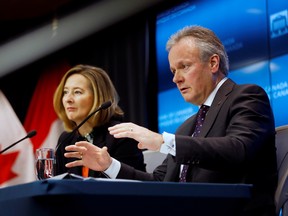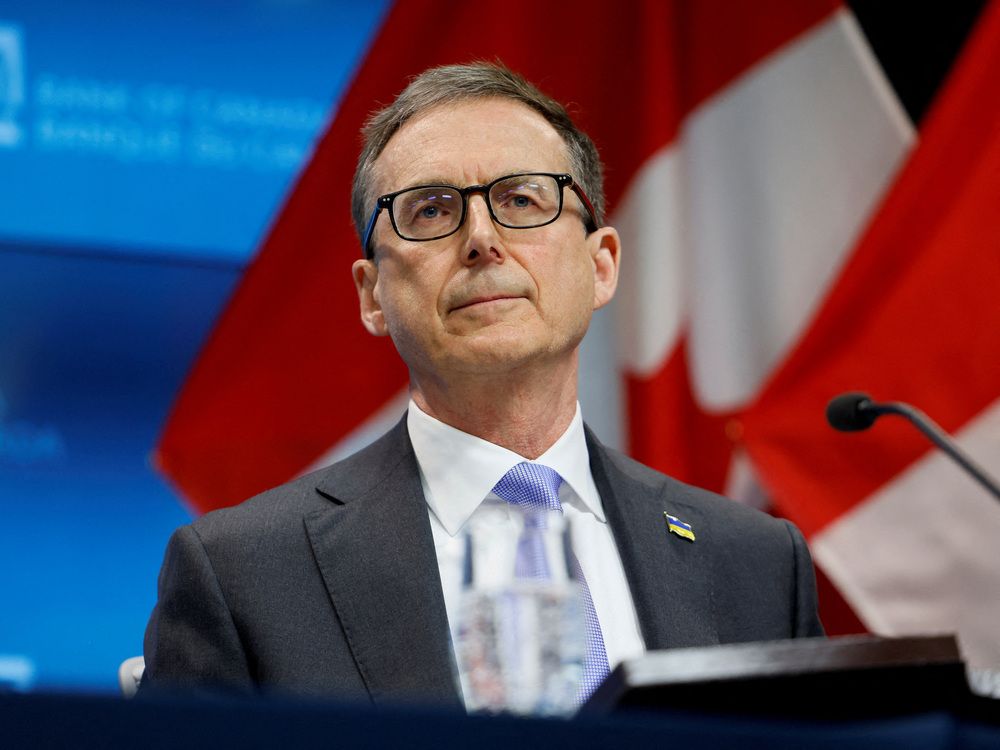There remains a certain amount of confusion about the Bank of Canada’s motivations thanks to a tweak to the mandate

Article content
Almost a year ago, the Bank of Canada unveiled its new marching orders from Chrystia Freeland, the member of Parliament who happened to be running the Finance Department when the central bank’s five-year mandate was up for renewal.
Advertisement 2
Article content
There was something odd about the years-long process that was barely noteworthy then, but might be complicating central bank governor Tiff Macklem’s efforts to contain the inflation outbreak now.
Article content
Ottawa’s decision in the 1990s to clarify who was in control of monetary policy by giving politicians a veto over the mission statement, and then leaving technocrats alone to implement that vision, is what the policy wonks call “good governance.” The public could be confident that the interest-rate setting was determined by the business cycle and not the election cycle, which hadn’t previously been the case.
Article content
At some point, the burden of maintaining confidence in the system shifted almost entirely to the central bank. The process that led to the 2021 mandate renewal was weird because the unelected participants in the process were far more transparent about what they hoped to achieve than the elected participants, who said almost nothing about the role they thought monetary policy should play in the economy.
Advertisement 3
Article content
Undeterred by political apathy, the Bank of Canada, under former governor Stephen Poloz and former senior deputy governor Carolyn Wilkins, conducted a masterclass in transparency. The flotsam left by the Great Recession included doubt about whether using inflation as a guide for interest rates still worked.
Poloz and Wilkins embraced the doubt. They consulted widely and publicly, beginning with a conference in 2017 at central bank headquarters in Ottawa that anyone with an internet connection could watch via livestream. They subjected alternative approaches to rigorous testing.

Macklem took over in 2020 and oversaw the compilation of an 84-page report on why the Bank of Canada decided to stick with an approach that had correlated with good results for three decades: raising and lowering interest rates to keep annual increases in the consumer price index (CPI) centred in a comfort zone of one per cent to three per cent.
Advertisement 4
Article content
“The Government of Canada and the Bank of Canada believe that the best contribution of monetary policy to the well-being of Canadians is to continue to focus on price stability,” the government and the central bank said in a joint statement in December 2021.
Yet there remains a certain amount of confusion about the Bank of Canada’s motivations, which might partly explain why Macklem felt compelled to restate his mission at the start of his speech about the labour market on Nov. 10.
That’s because the new mandate included a tweak: Freeland and Macklem added language that said the central bank would also seek to achieve “maximum sustainable employment” as long as the push didn’t jeopardize the “primary” objective of achieving “low, stable inflation over time.”
Advertisement 5
Article content
The addition simply made an implicit commitment explicit. The Bank of Canada has always kept an eye on employment because a certain level of economic growth is necessary to offset deflationary forces, policymakers’ enemy when inflation is at the low end of their comfort zone.
Yet some partisan observers saw a more significant shift. The previous mandate was released in the fall, and Macklem’s recommendations had been ready since the summer. Yet it took Freeland until December to sign off. Why the delay? Who knows, but it opened a door to questions about the Bank of Canada’s credibility.
It seemed harmless at the time. Then inflation blew up, and the attacks on the Bank of Canada’s credibility kept coming. Some Conservatives speculate the inclusion of explicit language around employment in the mandate meant Macklem was focused on Statistics Canada’s Labour Force Survey when he should have been watching the CPI.
Advertisement 6
Article content
At the same time, hardcore left-wingers accuse the Bank of Canada of ignoring its supposedly new employment mandate, because the central bank has purposefully slowed economic growth to a standstill in order to take the heat out of inflation. “An engineered recession will make the pain worse,” Jim Stanford, a former union economist who now leads the Centre for Future Work, tweeted earlier this fall.
-

Cooling labour market shows rate hikes are doing their job, says Bank of Canada chief
-

Canada’s blockbuster job numbers suggest economy still running hot
-

Bank of Canada is walking a fine line, but rates will go higher, says Tiff Macklem
The key word in the mandate is sustainable. Those who argue the Bank of Canada shouldn’t concern itself with the labour market are setting up a false ceiling for the country’s economic potential. Those who accuse the central bank of putting a number — two per cent — ahead of livelihoods are prioritizing their ideological preference for maximum employment, while de-emphasizing the risks of allowing the economy to run hot for too long.
Advertisement 7
Article content
Either could be the correct approach. But neither is certain, and the risks that come with going all in on either path are great. That’s why the Bank of Canada prefers to try to manage risks, rather than lock itself into a specific path. It will make mistakes, as it did last year by waiting a few too many months to begin raising interest rates to offset inflation. But more often than not, that approach should avoid serious trouble.
Macklem doesn’t want to cause a recession. But, as he told his audience in Toronto this week, he thinks he can take advantage of an unusually high number of job vacancies to cushion the blow of higher interest rates. He told reporters later that unemployment will rise, but by much less than typically happens during downturns. And he’s quite certain that if inflation persists, a significant recession will follow.
“That’s why we have front-loaded our interest-rate increases,” he said in his speech. “That’s why we are resolute in our commitment to return inflation to the two-per-cent target. To get there, we need to rebalance the labour market.”
• Email: kcarmichael@postmedia.com | Twitter: CarmichaelKevin



